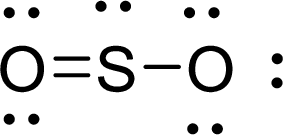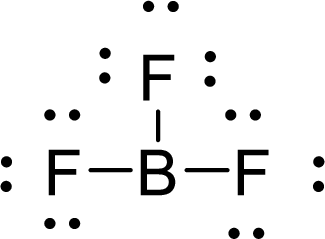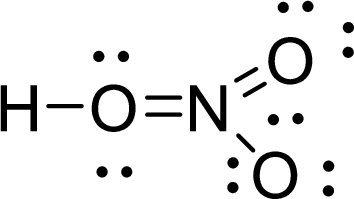
(a)
Interpretation:
The
Concept Introduction:
Bond angle is the angle between two bonds of a molecule and it is determined based on the electron-domain geometry.
(a)
Explanation of Solution
Given molecule is
The Lewis electron dot structure for

The electron-region geometry of Sulphur atom bonded to two other atoms and one lone pair of electron is triangular planar. It is a type of
(b)
Interpretation:
The
Concept Introduction:
Refer to (a).
(b)
Explanation of Solution
Given molecule is
The Lewis electron dot structure for
 .
.
The electron-region geometry of Boron atom bonded to three other atoms is triangular planar. It is a type of
(c)
Interpretation:
The bond angles of
Concept Introduction:
Refer to (a).
(c)
Explanation of Solution
Given molecule is
The Lewis electron dot structure for
 .
.
The electron-region geometry of first Carbon atom bonded to three other atoms is triangular planar. It is a type of
The electron-region geometry of third Carbon atom bonded to two other atoms is linear. It is a type of
(d)
Interpretation:
The bond angles
Concept Introduction:
Refer to (a).
(d)
Explanation of Solution
Given molecule is
The Lewis electron dot structure for
 .
.
The electron-region geometry of first Oxygen atom bonded to two other atoms and two lone pair of electrons is tetrahedral. It is a type of
The electron-region geometry of nitrogen atom bonded to three other atoms is triangular planar. It is a type of
Want to see more full solutions like this?
Chapter 7 Solutions
Chemistry: The Molecular Science
- Chemical species are said to be isoelectronic if they have the same Lewis structure (regardless of charge). Consider these ions and write a Lewis structure for a neutral molecule that is isoelectronic with them. (a) CN–, (b) NH4+ (c) CO3 2–arrow_forwardConsider the collection of nonmetallic elements O, P, Te,I, and B. (a) Which two would form the most polar singlebond? (b) Which two would form the longest single bond?(c) Which two would be likely to form a compound of formulaXY2? (d) Which combinations of elements would likelyyield a compound of empirical formula X2Y3?arrow_forwardThere are two main types of covalent bond breakage. In ho-molytic breakage , each atom in the bond gets one of the shared electrons. In some cases, the electronega-tivity of adjacent atoms affects the bond energy. In heterolytic breakage, one atom gets both electrons and the other gets none;thus, a cation and an anion form. (a) Why is the C−C bond in H₃C−CF₃(423 kJ/mol) strongerthan that in H₃C−CH₃(376 kJ/mol)?(b) Use bond energy and any other data to calculate the heat ofreaction for the heterolytic cleavage of O₂.arrow_forward
- The structural formulas for ethanol, CH3CH2OH, and propene, CH;CH=CH,2, are нн H Н—С—С—0—н H-C-C=C-H нн H H H Ethanol Propene (a) Complete the Lewis structure for each molecule showing all valence electrons. (b) Using the VSEPR model, predict all bond angles in each molecule.arrow_forwardConsider the molecules BF₃, PF₃, BrF₃, SF₄, and SF₆.(a) Which has bonds that are the most polar?(b) Which have a molecular dipole moment?arrow_forwardConsider the molecules SCl₂, F₂, CS₂, CF₄, and BrCl.(a) Which has bonds that are the most polar?(b) Which have a molecular dipole moment?arrow_forward
- (a) Methane (CH4) and the perchlorate ion (ClO4- ) are bothdescribed as tetrahedral. What does this indicate about theirbond angles? (b) The NH3 molecule is trigonal pyramidal, while BF3 is trigonal planar. Which of these molecules is flat?arrow_forwardWhich of the following bonds are polar? (a) B¬F,(b) Cl¬Cl, (c) Se¬O, (d) H¬I. Which is the moreelectronegative atom in each polar bond?arrow_forwardAn important starting material for the manufacture ofpolyphosphazenes is the cyclic molecule (NPCl₂)₃. The mol-ecule has a symmetrical six-membered ring of alternating N and P atoms, with the Cl atoms bonded to the P atoms. The nitrogen-phosphorus bond length is significantly less than that expectedfor an N−P single bond.(a) Draw a likely Lewis structure for the molecule.(b) How many lone pairs of electrons do the ring atoms have?(c) What is the order of the nitrogen-phosphorus bond?arrow_forward
- A common form of elemental phosphorus is the tetrahedralP4 molecule, where all four phosphorus atoms areequivalent:At room temperature phosphorus is a solid. (a) Are there anylone pairs of electrons in the P4 molecule? (b) How manyP¬P bonds are there in the molecule? (c) Draw a Lewisstructure for a linear P4 molecule that satisfies the octet rule.Does this molecule have resonance structures? (d) On thebasis of formal charges, which is more stable, the linear moleculeor the tetrahedral molecule?arrow_forwardA common form of elemental phosphorus is the tetrahedralP4 molecule, where all four phosphorus atoms areequivalent: At room temperature phosphorus is a solid. (a) Are there anylone pairs of electrons in the P4 molecule? (b) How manyP¬P bonds are there in the molecule? (c) Draw a Lewisstructure for a linear P4 molecule that satisfies the octet rule.Does this molecule have resonance structures? (d) On thebasis of formal charges, which is more stable, the linear moleculeor the tetrahedral molecule?arrow_forward(b) The Murchison meteorite that landed in Australia in 1969 contained 92 different amino acids, including 21 found in Earth organism A skeleton structure (single bond only) of one of these extraterrestrial amino acids is shown below. Draw a Lewis structure, and identify any atoms having a nonzero formal charge. H3N. C ČH2 ČH3 (c) Draw the orbital diagrams and Lewis symbols to depict the formation of Na* and CI ions from the atoms. Give the formula of the compound formed. (d) The predicted bond length for HF is 109 pm (the sum of the covalent radii of H, 37 pm and F, 72 pm), however the actual bond length for HF is shorter (92 pm). It was observed that the difference between predicted and actual bond lengths becomes smaller going down the halogen group from HF to HI Describe these observationsarrow_forward
 ChemistryChemistryISBN:9781305957404Author:Steven S. Zumdahl, Susan A. Zumdahl, Donald J. DeCostePublisher:Cengage Learning
ChemistryChemistryISBN:9781305957404Author:Steven S. Zumdahl, Susan A. Zumdahl, Donald J. DeCostePublisher:Cengage Learning ChemistryChemistryISBN:9781259911156Author:Raymond Chang Dr., Jason Overby ProfessorPublisher:McGraw-Hill Education
ChemistryChemistryISBN:9781259911156Author:Raymond Chang Dr., Jason Overby ProfessorPublisher:McGraw-Hill Education Principles of Instrumental AnalysisChemistryISBN:9781305577213Author:Douglas A. Skoog, F. James Holler, Stanley R. CrouchPublisher:Cengage Learning
Principles of Instrumental AnalysisChemistryISBN:9781305577213Author:Douglas A. Skoog, F. James Holler, Stanley R. CrouchPublisher:Cengage Learning Organic ChemistryChemistryISBN:9780078021558Author:Janice Gorzynski Smith Dr.Publisher:McGraw-Hill Education
Organic ChemistryChemistryISBN:9780078021558Author:Janice Gorzynski Smith Dr.Publisher:McGraw-Hill Education Chemistry: Principles and ReactionsChemistryISBN:9781305079373Author:William L. Masterton, Cecile N. HurleyPublisher:Cengage Learning
Chemistry: Principles and ReactionsChemistryISBN:9781305079373Author:William L. Masterton, Cecile N. HurleyPublisher:Cengage Learning Elementary Principles of Chemical Processes, Bind...ChemistryISBN:9781118431221Author:Richard M. Felder, Ronald W. Rousseau, Lisa G. BullardPublisher:WILEY
Elementary Principles of Chemical Processes, Bind...ChemistryISBN:9781118431221Author:Richard M. Felder, Ronald W. Rousseau, Lisa G. BullardPublisher:WILEY





